
Copyright © 2023 All rights reserved. Privacy Policy

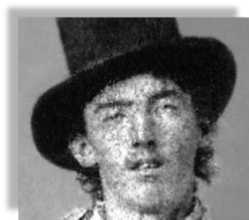
Billy The Kid
The ‘outlaw’ everybody’s heard of but knows nothing about.
I've been fascinated with the history of the American West since a boy, and for many years now with Billy the Kid in particular.
The more I read about his life the more I want to learn and try to understand. I hope you'll spend a few minutes here. I promise you'll find it fascinating. If it doesn't make you curious to find out more about Billy, at least it will dispel the myths in your mind about this enigmatic figure that everybody's heard of.

The photo far left is the only known authentic one of McCarty. This is a restored version, roll your mouse over to see the actual photo.
It’s a 2”x3” ferrotype taken in late 1879 or early 1880 at Fort Sumner and was passed down through the family of Dan Dedrick, a friend of Billy’s.
In 2011 the remaining original was sold at auction to billionaire William Koch for $2.3m.
Ferrotypes reversed the image, so Billy was in fact right handed, contrary to the popular myth. Although some accounts say he was ambidextrous and could shoot accurately from both hands. But there are other clues in the picture that it’s reversed: positions of shirt buttons and the loading gate on his Winchester rifle.
The head only photo (near left) shows his hat the correct way around as well some facial detail, his protruding front teeth for example.
The only known
photograph


- Born 1859, died 22 years later
- Real name: William Henry McCarty, Jr.
- Only one authentic photograph known to exist (above)
- Not the bandit killer described in the story books
- Badly let down by the author of ‘Ben Hur’ (read on!)
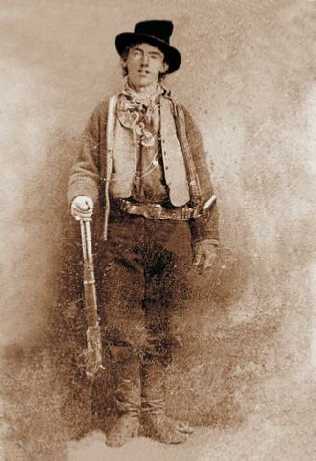
He was the product of what we now refer to as a broken home. He had a short and sad life, fending for himself in one of the toughest parts of the American West. But what shines through in the true story of Billy is not the psyche of a killer but the vibrant personality of a pleasant, unassuming young man, with a yearning for natural justice and an easy-going charm that made him very popular with the ordinary people he dealt with. He was no shrinking violet - you couldn't afford to be if you were making your way on your own in New Mexico in the 1870s - but he never robbed people, or banks, or harmed anyone unless it was in self defence or the pursuit of what he felt was right. As is often the case with a popular free spirit, he posed an imaginary threat to the powers that be, and his heroic exploits compounded this. He had to be eliminated.
Some brief background is in order. In the economic free for all that prevailed in most parts of the American West after the Civil War there were numerous factions with opposing interests: 'all of human life was there' as they say. Some of these characters you will have seen portrayed in western movies, for example there were the railroad barons, cattle barons, lawmen, miners, soldiers, politicians, as well as the ordinary farmers, homesteaders, itinerant cowboys, shop keepers, and so on. As with any society of human beings at any point in history, there were also the criminals, ranging from the pseudo politically motivated Jesse James, through the feckless who found it easier to steal than earn a living, to the outright psychopaths. Many were a mixture of these through their lives. Wyatt Earp for example was at various times a farmer, lawman, gambler, and miner; finishing up as an estate agent in Los Angeles in the 1920s.
Frictions occurred all the time between the various types of settler and what always amazes me when reading about the forging of the American West is the stark contrast between the often extremely violent clashes and apparent chaos, and the enormous faith placed by most citizens in legal structures which they enthusiastically struggled to assemble in their 'one horse' towns and counties, complete with judges, trained lawyers, writs, warrants and all the other formal paraphernalia. This consensus on due process helped forge workable communities out of the chaos.
The Civil War was the first major conflict in which industrial processes were used to mass produce firearms and at the end of the war nearly all of them stayed in circulation. Guns themselves don't precipitate violence but they help make it more intense, and some of the frictions between the different groups trying to make their way in the West boiled over into 'range wars' and the like. One such serious conflict was the so-called Lincoln County War which was triggered by a turf battle between two cattle ranchers who were also store keepers. It erupted into a five-day gun battle between the two sides and the enmity between those involved (and left alive) lasted for many years after. As you'll see, Billy the Kid played a role in the build-up to the Lincoln County War as well as the war itself. Incidentally, so you have the right idea of scale, these 'wars' were in fact fought between dozens of men at the most, and not hundreds. Lincoln, although still referred to today as a town, looks like what we know in England as a small village centred around one street and only had a few hundred inhabitants even in its heyday.

Note: The following has been gleaned from numerous sources and I am particularly indebted to Marcelle Brothers for parts of the following narrative. Thank you Marcelle. Marcelle is an assiduous researcher into all matters appertaining to Billy and her estimable web site is a mine of information. Please visit her site 'About Billy The Kid' by clicking here.
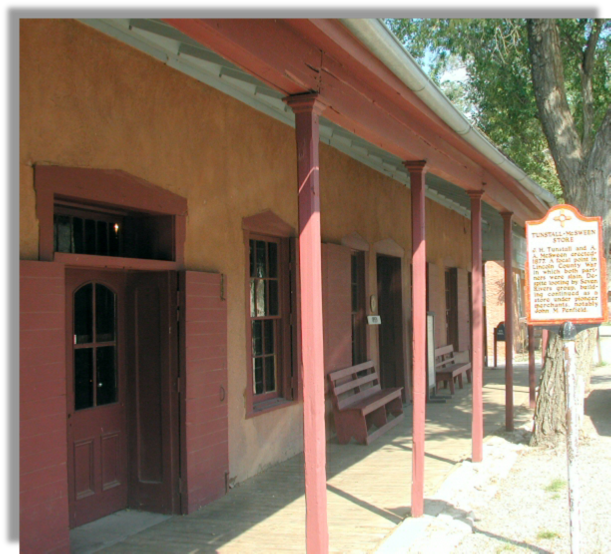
The Tunstall/McSween store today
Billy the Kid is probably the most misunderstood historical figure of the Old West. He was not a cold-blooded killer, nor a robber of trains or banks. Instead he was a gunfighter in a feud between two factions. The Lincoln County War would have turned out exactly the way it did if Billy the Kid never took part in it. His role in the Lincoln County War was minor - he wasn’t the leader but a follower. Although Billy the Kid was one of many who fought and killed during the War, he was the only one that faced conviction - all others were pardoned by the Governor to calm the area down - and he was sentenced to death. So Billy the Kid used his wit and courage to escape his date with the hangman which boosted his notoriety even more. If his spectacular escape wasn't enough, his controversial death was the final dramatic ending to his story. But it wasn't the end, Billy the Kid lives on in history and legend.
There's a strong and continued interest in Billy the Kid, not only because of his context in the history of the American West, but also because of the perennial fascination with a story involving injustice, murder, daring escapes, redemption, betrayal and a young life prematurely cut short. There's been an enormous amount of research over the last fifty years or so, resulting in a reasonably clear picture of his short life. What follows therefore is a very accurate historical account of that life, devoid of all the nonsense and legend that's built up over the years through 'dime novels' that were published in America immediately following his death, and the many movies made that have all singularly failed to portray what is an exciting but extremely poignant story that actually needs no embellishment. As an aside, the only film that comes close to an accurate portrayal of some of the events in Billy's life is Sam Peckinpah's "Pat Garrett and Billy the Kid".
Billy the Kid’s real name was William Henry McCarty. In his later teens he was known as Henry Antrim, after his stepfather, and William H Bonney, although no one knows the derivation of this alias. When and where he was born, or who or what happened to his father is not known. It’s estimated that he was born around 1860-61 possibly in New York. History first traces the Kid as a youngster in Indiana in the late 1860s and then in Wichita, Kansas in 1870. His mother Catherine McCarty was a widow and single mother and he had a younger brother named Joseph (born 1863). By 1871, Catherine was diagnosed with tuberculosis and was told to move to a climate that was warmer and drier.
On March 1, 1873 in Santa Fe, New Mexico, Catherine McCarty married a man named William Antrim. Since there were now two Billies in the household, the Kid’s mother referred to him by his middle name, he was now Henry McCarty-Antrim. The family moved to Silver City in Grant County, located in southern New Mexico. Catherine was suffering from consumption and her health began to deteriorate rapidly. Then on September 16, 1874, the Kid’s mother died.
Antrim didn’t want to be burdened with two small boys, so he separated them and placed them in foster homes and left Silver City for Arizona. The Kid now had to earn his own keep, so he was put to work washing dishes and waiting on tables at a restaurant. After a year of no parental guidance and looking out for himself, the Kid quickly fell in with the wrong crowd. One of his troublemaking buddies, Sombrero Jack, stole some laundry from a Chinese laundry cleaner and told the Kid to hide the bundle. The Kid got caught with it and was arrested. The county sheriff decided to keep him locked up for a couple of days just to scare him, but the Kid escaped and ran away.
Here's a piece from The Silver City newspaper at the time: “Henry McCarty, who was arrested Thursday and committed to jail to await the action of the grand jury, upon the charge of stealing clothes from Charley Sun and Sam Chung, celestials, sans cue, sans Joss sticks, escaped from prison yesterday through the chimney. It’s believed that Henry was simply the tool of Sombrero Jack, who done the stealing whilst Henry done the hiding. Jack has skinned out.”
The Kid fled to one of his foster families and they put him on a stagecoach to Clifton, Arizona where his stepfather was living, but when he found his stepfather he didn’t want him and told the Kid to leave. All alone in a strange desert, the Kid wandered from one ranch to another to find work. For the next two years the Kid tramped around as a ranch hand and gambler. He then met up with a horse thief name John Mackie who taught him the tricks of the trade and the two became partners. But after some close calls, arrest, and escaping from custody, the Kid decided it was wiser to give up his new occupation. He returned some stolen horses to the army to clear himself and got work as a ranch hand.
One day while at a saloon in Camp Grant, Arizona, the Kid who was about sixteen at the time, got into serious trouble. He got into an argument with a bully named Frank “Windy” Cahill, who had picked on him numerous times before. After some name-calling, Cahill rushed the Kid and slammed him down on the ground, then jumped on top of him and proceeded to slap him in the face. The Kid worked his hand free to his revolver and fired it into Cahill’s stomach. When Cahill fell over the Kid squirmed free, ran off, and mounted the nearest horse and fled Camp Grant.
Billy didn’t stay around to face murder charges and left Arizona and returned to New Mexico. Now an outlaw and unable to find honest work, he met up with another outlaw named Jesse Evans, who was the leader of a gang of rustlers called “The Boys”. The Kid didn't have anywhere else to go and since it was suicide to be alone in the hostile and lawless territory, he reluctantly joined the gang.
The gang made their way to Lincoln County where the Boys joined forces with James Dolan, who was currently in a feud against a young English entrepreneur named John Tunstall and his attorney and partner Alex McSween. The feud would flare up and be famously known as the Lincoln County War. Essentially, Tunstall had decided to set up business as a cattle rancher and store owner. The problem was that a group of Irish 'businessmen', Murphy, Dolan and Riley, held the monopoly of supplying beef to the local Army posts and also owned the only store in Lincoln, until Tunstall arrived. (NB: Lincoln was more a village than a town at the time, with only around 450 inhabitants. Today the population has shrunk to around 75).
James Dolan was the protégé of one L G Murphy and when Murphy became ill with cancer and hospitalized in Santa Fe, Dolan stepped up to take his place. Supporting Dolan was the powerful and secretive Santa Fe Ring (similar to a mafia) in which members consisted of the governor, politicians and attorneys, most being Freemasons and members of the same lodges. They existed to 'scratch each other's backs' in terms of business deals, particularly those where the Government was a customer. One of their scams was to sell sub-standard cattle to the army, like at Fort Stanton near Lincoln, having first obtained approval to a sample of the herd - consisting of specially fattened-up specimens bearing no resemblance to the rest of the delivery. (Some individuals at Fort Stanton were almost certainly involved which could partly explain some events later on).
Dolan didn’t like competition arriving in the form of Tunstall and set out to drive him away. Tunstall refused to be intimidated and instead tried to fight back with legal action. When Tunstall realized he couldn't fight his enemies the legal way due to the bias Judge Bristol and Governor Sam Axtell, Tunstall decided to fight fire with fire and hired his own gunmen. The feud then turned into an all out war.
The Boys started to steal Tunstall’s livestock, so arrests were made and the Kid eventually was caught and placed in jail. Tunstall noticed something different about this rustler; he wasn’t rough like the other men, but just a boy who got a bad start in life and was looking for a place to belong. So Tunstall gave him an ultimatum: if he testified against the other rustlers, he'd hire him as an employee. The Kid took Tunstall’s offer.
Now fighting for the Tunstall side and in the hopes of a better future, the Kid changed his name to William H. Bonney, but his friends called him “Kid.” Tensions were high and the feud between Dolan and Tunstall escalated into bloody violence. John Tunstall was brutally murdered by members of Sheriff Brady’s posse and The Boys. Tunstall’s ranch hands then formed a vigilante group called “the Regulators” and the war was on.
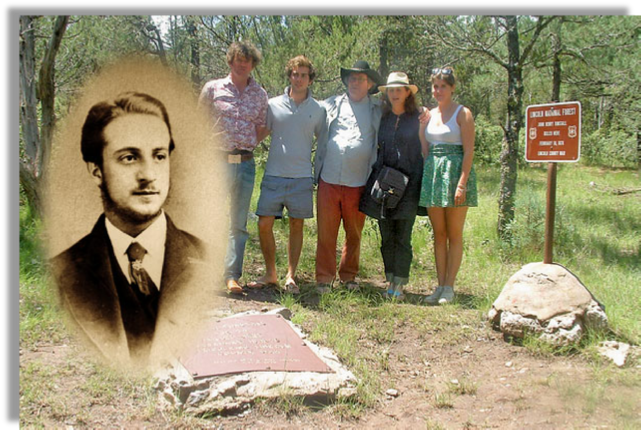
A touching photo: descendants of John Tunstall travel in 2010 to visit the spot outside Lincoln where their ancestor (inset photo) was shot down in cold blood. The story of the visit can be found on True West Magazine’s web site here.
In the photo above, the white cement base on the right was the original Forest Service marker. The flat plaque on the left was added in 1978 to mark the centenary of the murder by the Lincoln County Historical Society.
At first the deputized Regulators tried to do things legally by serving warrants, but with the prejudiced Sheriff Brady and the biased court system, they couldn’t count on justice being served, so they took the law into their own hands. They retaliated by killing the men they knew were responsible for Tunstalls' murder, Bill Morton, Frank Baker and William McCloskey. Then they ambushed and killed Sheriff Brady and his deputy George Hindman in Lincoln. Lastly, they had a dramatic gunfight with Dolan gunman, Buckshot Roberts, at a place called Blazer's Mill but during that shootout their leader Dick Brewer was killed.
Note: The Regulators were particular bitter towards Bill Morton, because he led the posse that murdered Tunstall and was one of those that actually shot him. As for William McCloskey, he was a Regulator suspected for playing both ends of the table and tried to intervene in Morton and Baker’s execution after the Regulator’s arrested them. As for the Brady shooting, six members of the Regulators (the Kid included) ambushed the sheriff and four of his deputies from behind a wall as they walked down the street in Lincoln to arrest Alex McSween.
The Regulators' revenge only made things worse. They were now viewed as the bad guys and warrants were put out for their arrest.
Now the Dolan side struck back. Dolan's gunmen and the newly appointed sheriff, George Peppin and his men, had the McSween house surrounded with Alex McSween and many of the Regulators trapped inside. Dolan sent for Colonel Dudley, a crony, at Fort Stanton for assistance. The Colonel came with troops along with a Howitzer and Gatling gun. On the fifth day of the siege the Dolan side was getting impatient, so they set the house on fire. By nightfall, the house was completely ablaze and heat from the flames was overwhelming. The Regulators began to panic, so the cool-headed Billy the Kid, only about seventeen years old, took over leadership of the men. As night fell he divided the men into two groups; he lead his party out the door first and ran in one direction so as to draw the line of fire towards them so McSween’s party could make a run in another direction and get away. When the men began to run out of the burning house the Dolan side opened fire and all hell broke loose. McSween and three men were killed, but Billy the Kid and the others escaped into the darkness.
The war was over; the Regulators disbanded and the Kid was now a fugitive.
Billy the Kid was unable to settle down, so he made his living by gambling and rustling cattle. The Kid heard about Governor Axtell being replaced by Lew Wallace, who was now trying to bring law and order to Lincoln. (Interesting fact: Lew Wallace's main claim to fame was that he wrote 'Ben Hur'). The Kid wrote to the governor that he was tired of running and would surrender to the authorities and testify against the Dolan side to have his murder charges dropped. The Governor agreed and promised the Kid a full pardon.
The Kid surrendered and testified in court, but the Santa Fe Ring had influence over the court system, so members of the Dolan side, including James Dolan, were acquitted. The Kid was in unfriendly territory and one of his threats was prosecutor attorney William Rynerson, who was part of the “Ring” and wanted to put the Kid on trial for the murder of Sheriff Brady. The Kid felt betrayed when he learned that Governor Wallace didn’t have the power to pardon him without Rynerson’s cooperation, nor was the governor pressuring the attorney to collaborate. Wallace simply lost interest and left the Kid to his fate. There's no doubt he was let down badly. Billy the Kid knew he didn’t stand a chance in court and he had lost faith in the governor, so he escaped. Some of Billy's poignant letters to Governor Wallace are shown at the end of this page here.
On the run again and an outlaw, the Kid went back to making a living the only way he knew how – rustling. There were other outlaws and rustlers in New Mexico, much worse than Billy the Kid, but the Kid had gained fame and was singled out by the newspapers who had built him up into something he wasn’t. It was the newspapers that had given him a name that he would forever be known as: “Billy the Kid.”
Since the end of the Lincoln County War, the Kid spent the next two years eluding the law and living in and around Fort Sumner (a former military fort transformed into a tiny Mexican village). While in Fort Sumner, he would kill a drunk at a saloon, but the killing was shrugged off and got almost no attention, but unfortunately, the Kid got into more serious trouble that did get plenty of attention. It happened when a posse from White Oaks surrounded the Kid and his gang at a station house. During the standoff the posse accidentally killed their own deputy, James Carlyle. Of course the death was credited to the Kid and destroyed any ounce of sympathy the public had for him, not to mention, any chance for him to get things squared up with the governor to get his pardon.
Before the shooting, Billy the Kid sensed trouble from a man named Joe Grant and he casually went up to him and asked to see his gun. As he pretended to admire it, he spun the cylinder so the hammer would fall on an empty chamber. This wise precautionary move saved the Kid's life, because Grant then pulled his gun on him and fired. The gun of course just clicked and then the Kid had his turn but his gun went BANG.
As the Kid dodged the law, Pat Garrett was elected sheriff and made US Marshal to hunt for Billy the Kid. He was familiar with the Kid’s habits and hideouts, which may show that Garrett may have been a rustler himself or at one time may have ridden with the Kid. During his pursuit Garrett ended up killing two of the Kid’s closest comrades, Tom O’Folliard and Charlie Bowdre. Finally on December 23, 1880 Garrett trapped the Kid and three other gang members at a cabin in Stinking Springs. After a short standoff, Billy the Kid came out and surrendered. One story has it that it was winter time and Garrett resorted to the ruse of frying bacon and brewing coffee until the cabin's occupants could stand it no more!
Billy the Kid was quickly put on trial in Mesilla and was sentenced to hang for the murder of Sheriff Brady. After his sentence was passed, the Kid was taken to Lincoln to await his execution.
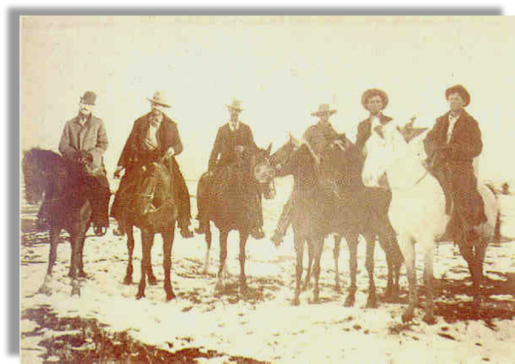
Rarely-seen photo of Billy when captured at Stinking Springs, December 24th 1880. Pat Garrett is recognisable extreme left and Bob Olinger is next to him. Billy is on the extreme right where a deputy aims a Colt revolver at Billy's head. One of Billy's compadres, Charlie Bowdre, had been killed in the encounter.
BUT: Although the weather conditions tally the figure on the far left looks too short for Garrett who was about 6’ 3” and the figure on the far right looks too tall for Billy who was about 5’ 8”.
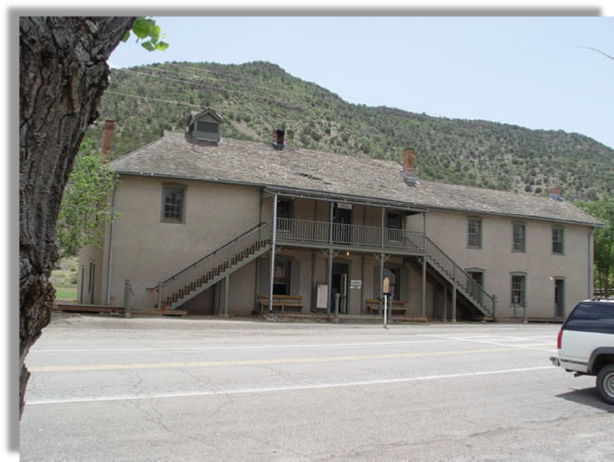
Lincoln County Courthouse today, where Billy the Kid was kept and made his escape.
In 1881 the stairs on each side of the balcony had not yet been added. Billy was kept in the room top left which also has a window on the side elevation (see next pictures).
The Kid was shackled and imprisoned in a room in the Lincoln courthouse as two deputies took turns guarding him, James Bell and Bob Olinger.
On Thursday April 28, 1881 the Kid made his most daring escape (which would also be his last). The Kid was successful in getting a drop on the lone guard, Deputy James Bell, by slipping his hand out of the handcuffs and using the heavy restraints to hit the deputy over the head. The Kid then jerked Bell's pistol and told him to throw up his hands, but instead the deputy ran and the Kid had no choice but to shoot him. Another story, the one portrayed in Peckinpah's Pat Garrett and Billy the Kid, has Billy retrieving a pistol left in the outside privy by a friend, but the weight of evidence is that he snatched Bell's gun. Billy was known to have extremely slender hands - a point overlooked by many a lawman - and he could usually slip out of hand shackles fairly easily.
The other guard, Bob Olinger, was across the street having lunch at the Wortley Hotel (Billy's food was taken over to him from the Wortley) when he heard the gunshots. He ran toward the building and as the Kid saw him approaching he shot Olinger down with a shotgun.
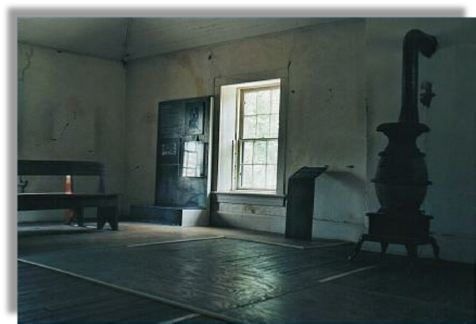
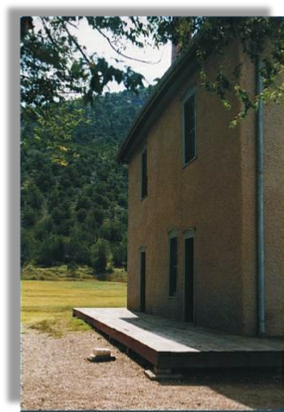
The upstairs room in the Courthouse where Billy was kept.
The marker on the ground is where Bob Olinger fell, shot by Billy from the upper near window.
Bob Olinger was a bully and an old enemy of Billy the Kid. He'd taken pleasure in tormenting the helpless prisoner and used his shotgun to intimidate him. So when Olinger ran to the courthouse, the Kid didn’t hesitate to shoot him with his own shotgun. The Kid’s original plan of escape was to take Bell prisoner, lock him up, and slip out unseen before Olinger came back. The Kid rode out of Lincoln a free man and headed to the only place he could call home: Fort Sumner.
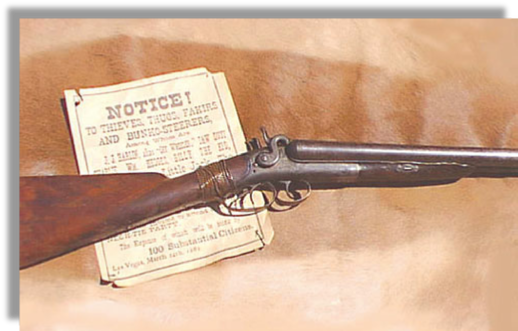
The Bob Olinger's shotgun. Is that a wired repair to the break Billy made after shooting Olinger?
The Kid decided to lay low long enough until the law would give up hunting him and he could “rustle” up some money and leave the territory. By July of 1881, Garrett heard rumours that Billy the Kid was in the Fort Sumner area, so with two deputies he rode into Fort Sumner.
On July 14, 1881 just before midnight, Pat Garrett (pictured below) waited till the town was quiet before he slipped into Pete Maxwell’s room to ask him about Billy the Kid. Garrett was a former employee of Pete Maxwell's and it's possible that Maxwell tipped Garrett off that the Kid was in the area. At that exact moment, the Kid with a knife in hand went to Maxwell’s house to get some fresh beef for a late steak dinner. As he approached, he saw Garrett’s two deputies on the porch and since he didn't recognise the strangers, he backed cautiously into Maxwell’s room and asked “Pete, who are those fellows outside?” He got no answer and as he walked towards the bed, he saw Garrett’s silhouette and started to back away and asked in Spanish, “Who's there?” Garrett recognized the Kid’s voice and fired his gun. The bullet pierced the Kid's heart and he fell to the floor. Garrett and Maxwell ran out of the room and huddled outside with the two deputies and waited. They could hear as the Kid gasped for breath and then all was quiet - Billy the Kid was dead.
It’s of great speculation whether or not the Kid was armed with a gun. There's also something fishy about this whole incident and there may have been more foul play then we're led to believe. Garrett may have deliberately been waiting in the dark to shoot the Kid. The next day Billy the Kid was buried at the Fort Sumner cemetery near his two fallen companions, Tom O’Folliard and Charlie Bowdre.
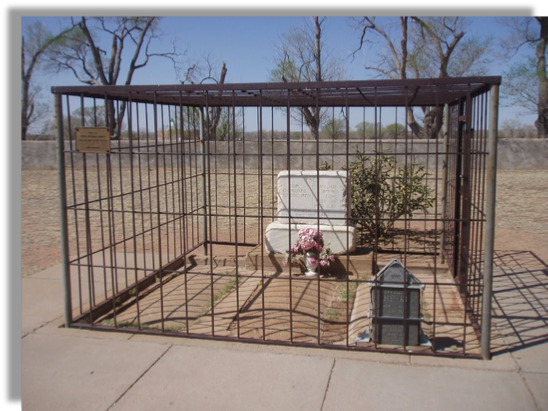
Billy the Kid's grave today, Fort Sumner, New Mexico.
Billy was killed not for who he really was, but for what people thought he was. He was a pawn in losing game and he was made a scapegoat for other outlaws’ crimes. Although he did participate in killings, the men he fought against were much worse than he ever was, and this was a tough territory in tough times where you had to rely on your own abilities to defend yourself. This nineteen or twenty year old lived a short life but made a lasting impression. If it weren’t for our attraction to Billy the Kid, the history of the Lincoln County War and its participants would've been long forgotten. Thanks to Billy the Kid, New Mexico has a thriving business in tourism as a steady flow of tourists each year come to visit the Billy the Kid sites. Even in death Billy the Kid is likeable and he has a large following with people all over the word. Billy the Kid is known as the Old West's favourite outlaw.
Footnote: In 2004 the Governor of New Mexico was petitioned to grant Billy the Kid the pardon he was wrongfully denied in 1878 when Governor Wallace pardoned all the other participants. Descendants of Sheriff Brady strongly objected, so the idea was dropped. Governor Richardson (2003-2011) admitted he'd allow a period of controversy to elapse in the interest of promoting New Mexico's tourist trade and in 2011 he announced there would be no pardon due to ‘historical ambiguity’.
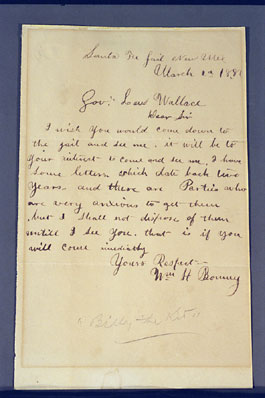

Billy’s Letters to Governor Lew Wallace
Santa Fe Jail,New Mexico
March 2nd 1881 (Pictured above)
Gov. Lew Wallace
Dear Sir,
I wish you would come down to the jail and see me. it will be to your interest to come and see me. I have some letters which date back two years, and there are Parties who are very anxious to get them but I shall not dispose of them until I see you. that is if you will come imediately.
Yours Respect-
Wm H. Bonney

Santa Fe Jail,New Mexico
March 4th 1881
Gov. Lew Wallace
Dear Sir
I wrote You a little note the day before yesterday but have received no answer. I Expect you have forgotten what you promised me, this Month two years ago, but I have not and I think You had ought to have come and seen me as I requested you to. I have done everything that I promised you I would and You have done nothing that You promised me.
I think when You think the matter over You will come down and See me, and I can then Explain Everything to You.
Judge Leonard Passed through here on his way East, in January and promised to come and See me on his way back, but he did not fulfill his Promise. It looks to me like I am getting left in the Cold. I am not treated right by Sherman, he lets Every Stranger that comes to see me through Curiosity in to see me, but will not let a Single one of my friends in, Not even an Attorney.
I guess they mean to Send me up without giving me any Show but they will have a nice time doing it. I am not intirely without friends.
I shall Expect to See you some time today.
Patiently Waiting
I am truly Yours Respect-
Wm. H. Bonney

Santa Fe Jail,New Mexico
March 27th 1881
Gov. Lew Wallace
Dear Sir
For the last time I ask, Will you keep your promise. I start below tomorrow send awnser by bearer.
Yours Respt-
W.Bonney
Governor Wallace never replied.

Books About Billy
Of the many books written about Billy the Kid and the Lincoln County War I found the following to be the best. Click on their titles to go to Amazon.co.uk to see more about them and/or buy them. There’s also a link below where you can search for a particular title on Amazon.
Billy The Kid: A Short and Violent Life - Robert Utley
Professionally researched and written; particularly strong on piecing together Billy's movements at the crucial times. An excellent and sound source.
The West of Billy The Kid - Frederick Nolan
Frederick Nolan is English and yet one of the foremost experts on Billy the Kid, publishing his first book on the subject in 1965. This is a superb volume published in 1998 and has nearly 300 photographs. The link goes to the hardback version - buy this one as it's a sumptuous book to own.
History of the Lincoln County War - Maurice Fulton
Maurice Fulton was an important Western historian who carried out a lot of new research on Billy the Kid and the Lincoln County War, unfortunately dying before publishing his work. Robert Mullin, another Western historian, completed the work for publication. It's a highly detailed account of the often labyrinthine events leading up to the Lincoln County War, but nevertheless very readable.
They ‘Knew’ Billy The Kid: Interviews with Old Time New Mexicans - R Kadlec (Editor)
A slim but fascinating volume. In the 1930s, as part of a work creation programme in the Depression years, a number of writers went into the field and interviewed people who knew some of those involved in the Billy the Kid saga including Billy himself, and set down their reminiscences. Many of those would have been in their 60s or more, and by the 1930s there was already a folklore surrounding Billy the Kid that may have coloured their memories. For all that, the interviews are a fascinating glimpse into another time and add lots of useful background to things as well as providing the odd genuine first hand account of key events.

Films About Billy
As everyone knows, ever since the Hollywood film industry began it has done a disservice to portraying anything like the true nature of the American West. Films purporting to show Billy The Kid’s story number over fifty and not one makes anything lke an accurate portrayal of his life and times. Young Guns (1988) uses a lot of the points of reference but that’s about it.
The film that comes closest the story and atmosphere of the time is Sam ‘Peckinpah’s ‘Pat Garrett and Billy The Kid’ (1973). It only deals with post-Lincoln County War events but has an engaging melancholy feel that fits the nature of the story of Billy’s demise. Bob Dylan’s ‘acting’ appearances are risible but his film score is simply perfect, winning a Grammy nomination. The film has appeared in various cuts and a 2005 DVD included improved versions with restored scenes, but a definitive full version in Blu-ray is long overdue.
For a fuller discussion of the Billy The Kid filmography visit this page of Marcelle Brothers’ excellent site.
Numerous documentaries have been done over recent years and are available on DVD but most of them are shallow and thinly researched. The only one I can strongly recommend was made in 2012 by the US PBS channel in their excellent ‘American Experience’ series. It includes intelligent contributions from leading experts including best in my opinion, Frederick Nolan. Here is a link to the DVD at Amazon.co.uk. You can see more details and an excerpt from it here on the PBS web site.
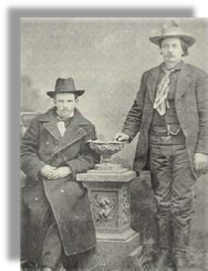
Jimmy Dolan and Bob Olinger -
demonstrates whose side Olinger was on!
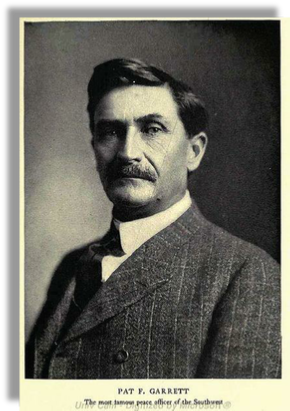
Billy's nemesis

Billy The Kid’s grave is at Fort Sumner, New Mexico. In 1904 the Pecos broke its banks and flooded the entire area including the military cemetery for a week to a depth of four feet, washing away or moving most of the markers and stones. So in 1906 all the bodies in the military graves 'on the western side of the cemetery' were disinterred and reburied at Santa Fe National Cemetery. The Kid's remains may have been moved at the same time.
In 1932 local residents determined the location of the grave and placed the 'Pals' white tombstone (see above),noting three individuals buried in the cemetery, Tom O'Folliard, Charlie Bowdre, and William H. Bonney.
In 1940 Warner Bros. used a Billy The Kid grave marker as a prop in the movie The Outlaw. James N. Warner donated this marker to the cemetery when it was no longer required for the movie. This individual grave marker was placed as a footstone with a pointed top. This marker was stolen and recovered twice. It was first stolen in August 1950, and not recovered until 25 years later, in May 1976, in a field on a ranch near Granbury, Texas. Local resident Joe Bowlin brought it back, and it was ceremoniously re-installed that June. It was stolen again in February 8, 1981, but recovered days later in Huntington Beach, California. New Mexico Governor Bruce King arranged for the Sheriff of the county seat to fly to California to bring it back to Fort Sumner where it was re-installed in May 1981. A short time later, the village, which owned the cemetery at the time, erected a steel cage to protect the grave site, preserved the chipped-away white headstone, and placed Billy's individual footstone in shackles, to discourage further vandalism and theft. On June 16, 2012, a group of vandals entered the cage at night and tipped over the stone.

Billy Chronology

There is a useful chronology of the events in Billy’s life here . My thanks to Corrine Casal for tracking this down and letting me know about it. I’m glad you enjoyed finding out more about the true story of young Billy and his contemporaries!
| The 1960s |
| The 1970s |
| The 1980s |
| The 1990s |
| The 2000s |
| The 2010s |
| The Cast Part 1 |
| The Cast Part 2 |
| Videos 1 |
| Videos 2 |
| Billy The Kid |
| Oscar Wilde |
| The Trials |
| De Profundis |